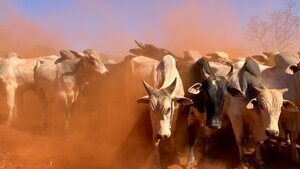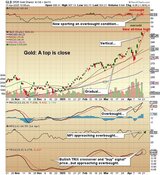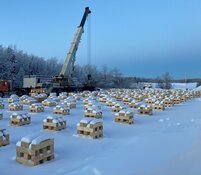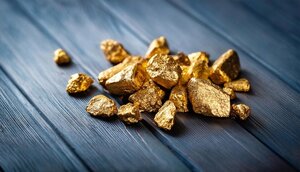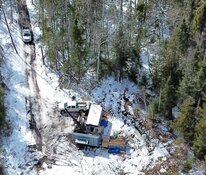The Gold Report: The Indaba Mining Conference in Cape Town, South Africa, is an ideal spot to take the pulse of the global mining business. You were there in February. What did you learn that could benefit mining equity investors?
Nana Sangmuah: The key takeaway is that exploration has left the scene and it's no longer a core focus in weak equity markets. The focus on conserving margins by both senior and intermediate metals producers meant slashing exploration budgets. Those miners will not be able to replenish the reserves they are mining and are probably mining themselves out of business. The only way to correct this—given the 10- to 12-year gap from discovery to production—is for merger and acquisition (M&A) activity to pick up in a big way. Most of the conversations at Indaba went in that direction given the compelling valuation available in the sector.
"Asanko Gold Inc. is fully funded, but it is not trading at the level of its fully funded peers."
What was also striking is the increase in companies saying publicly that they are on the hunt for acquisitions. Those included Randgold Resources Ltd. (GOLD:NASDAQ; RRS:LSE), Newmont Mining Corp. (NEM:NYSE), Newcrest Mining Ltd. (NCM:ASX) and Acacia Mining Plc (ACA:LSE) (formerly African Barrick Gold Plc). But, quite frankly, there is a short list of potential targets.
TGR: Did the M&A chatter focus on African assets?
NS: It's clearly heating up on the continent. I can count about six transactions in Africa over the past 16 months. The time needed to advance projects seems to be much quicker on the continent because a lot of countries have a significant portion of their gross domestic product tied to the mining sector; those governments are more willing to get projects moving. The biggest problem is infrastructure and it adds to the cost of getting projects up and running.
TGR: Metal prices were a significant topic of discussion at Indaba. Was there a consensus on which metals offer the most upside?
NS: Metal prices are always an issue. Generally, there's a view that the strength in the U.S. dollar is not going to be sustainable beyond H2/15. Any potential weakening of the dollar should translate into stronger commodity prices. As with all the currency wars, there could be an increased investment demand for gold as a currency that cannot be manipulated by any central bank. But the reality is almost all the current mine supply is being gobbled by Asian demand. Central banks are not selling, so any increase in investment appetite should drive the gold price a lot higher.
TGR: Please give our readers your price decks for gold and silver.
NS: For valuation purposes, we've kept our gold price deck flat at $1,350 per ounce ($1,350/oz). We expect a stronger second half for gold. We've seen it test $1,300/oz and pull back. We think gold can leap on a weaker U.S. dollar and increased fiscal buying from Asia.
TGR: And silver?
NS: We have $18/oz. Silver should mirror the movements in the gold price. I don't expect any significant increase in industrial demand because global economies remain weak. Any movement will be U.S. dollar-related.
TGR: What should investors focus on as they conduct their due diligence on mining equities?
NS: The key is to watch how individual company mine plans look beyond three years. Typically, companies provide three-year production growth and free cash flow forecasts and that's it. But a lot of these companies have handicapped their mine plans by focusing on high-grade ore. Beyond that, the grade is not economic and there's little value there. The focus should be on what will happen beyond that timeframe and the companies that have stories to tell. Some examples are Randgold and Acacia Mining, that have a 10-year and a 5-year mine plan respectively. Those situations are the ones that investors should gravitate to because those longer mine plans are fully funded at these price levels.
TGR: What are some of your favorite investor-friendly mining jurisdictions in Africa?
NS: The jurisdictions that I prefer are ones that are sympathetic to market conditions and will give companies a tax break when commodity prices are soft. They have a sliding scale royalty. Two that come to mind are Côte d'Ivoire and Burkina Faso. Those are the go-to jurisdictions in this economic environment.
TGR: What are some others where the negative perception doesn't match the general reality?
NS: Perhaps Ghana. Its power infrastructure is problematic but it can be fixed. There's still a lot of good opportunity in that country, not only in gold but in base metals, too. I spoke with Ghana's mines minister at Indaba. He said the government is making every effort to fix the power situation, which will increase government revenue. It has become political, and either the government gets its act together to fix the power deficit or it will be voted out of power in 2016. Part of the problem is a result of mismanagement of the existing infrastructure, which is not too difficult to correct.
TGR: What are some key things that mining equity investors need to know about African operations that they don't have to know about in the West?
NS: Regardless of the jurisdiction, you have to know the track record of management teams. People who have operated in Africa understand that they need to build stakeholder interest and from that comes the social license to operate. Even when some jobs are provided to the local community where the mine is located, the local people will still ask for more. Community engagement enables companies to let local populations know that they are being heard. These are soft issues and if companies get them right, they can always turn a profit, like Randgold. Its operations have been successful even in dire circumstances, like a civil war in the northern part of the Democratic Republic of the Congo, and even in Mali. Randgold is hands down the best gold mining company to unlock value over the next 10–15 years in the mining industry—and all its mines are in Africa.
TGR: The government in Mali says Randgold owes it $46 million ($46M) in taxes. How do you expect that dispute to end?
NS: It's basically about different interpretations of the mining code, which has been changed several times, but Randgold had some grandfather clauses in the initial code that led the company to invest in the country. The issue has been sent to arbitration and will likely be resolved with little or no impact to shareholders. Randgold has returned a lot of dividends to the Malian government and it will probably want to keep the golden goose alive.
TGR: Randgold has done some takeovers in recent years and CEO Mark Bristow told an audience at Indaba that 2016 looked to be the right year to make an acquisition. What are some likely targets?
NS: Randgold has set a threshold for acquisitions using returns of 20% at $1,000/oz gold for resources that would be 2+ million ounces (2+ Moz). It's really hard to find anything that meets that criteria. The only one that comes close is Asanko Gold Inc. (AKG:NYSE.MKT; AKG:TSX) in Ghana, which would be close to a 20% internal rate of return at $1,000/oz gold. Randgold could also look at the assets of other major operators with huge debt and little cash—like the Obuasi mine in Ghana—27 Moz at 5.4 grams per ton (5.4 g/t). Randgold has already unlocked value at Kibali, a joint venture with AngloGold Ashanti Ltd. (AU:NYSE; ANG:JSE; AGG:ASX; AGD:LSE). Similar situations could make a lot of sense.
TGR: Asanko has made a number of additions to its management team over the last year. Does it now have the people in place to execute its phase one mine plan at the Nkran pit?
NS: Of the development companies that I follow, Asanko is probably the best suited to transition from development to production because it has a team that has worked together for quite some time. The execution risk here is very low. The contractor that is building the mine, DRA, has built about seven mines already with the Asanko management team. The power infrastructure in Ghana could be an issue but management is working on a contract with an independent power provider with excess capacity in the country so that it has a stable source of power.
TGR: What are your picks among mining equities with core operations in African countries?
NS: For producers, Randgold is definitely one that has shown it's going to continue to do well. Even at a gold price of $1,000/oz, the company can generate free cash flow, which can be returned to shareholders via dividends or deployed into further acquisitions for growth.
Another is SEMAFO Inc. (SMF:TSX; SMF:OMX). It has devised a growth strategy that probably puts it among the top producers, with a good balance sheet, solid growth profile and good execution track record. SEMAFO can continue to generate free cash flow even at $1,000/oz gold. Only a few companies can do that in this current environment.
Among the developers, Asanko is a no-brainer. It's fully funded, but it is not trading at the level of its fully funded peers. This valuation discount should start dissipating once the market realizes that development is going smoothly. There is an investor site visit tour scheduled for May. Asanko has a good management team that can derisk this asset and move it to production in Q1/16.
TGR: SEMAFO's new SAG mill upgrade at Mana is up and running. What's the next step?
NS: SEMAFO grew into production to the 250,000 oz (250 Koz) level by the discovery of Siou, a very rich high-grade satellite deposit near Mana that has reserves for about five years. It has further resources that could be converted to reserves. It's going to generate about $100M in free cash flow this year and that is sustainable for the next five years.
The question is what happens beyond that? The first issue is to successfully close the acquisition of Orbis Gold Ltd. (OBS:ASX), which is developing the Natougou high-grade gold deposit in Burkina Faso. We're talking about 2 Moz at about 3.4 g/t gold. SEMAFO must accelerate that project to production. If it does, we could see an additional 200 Koz added to the company's production profile over the next three years or sooner. I think SEMAFO has cemented its position as one of the companies with a solid balance sheet and a good margin profile that can sustain solid free cash flow even at $1,000/oz gold. It warrants a premium. Frankly, I see it as a target for larger gold mining companies struggling to lower their cost profiles.
TGR: Are there other producers that you cover in Africa?
NS: I cover IAMGOLD Corp. (IMG:TSX; IAG:NYSE). The company has done well to bring its cost profile lower, but if I run it through my numbers, the company is still not going to generate free cash flow this year. It has about $800M in cash and bullion, and essentially, IAMGOLD needs to acquire something to help lower its cost profile. The company is open to all jurisdictions, but probably would not want to overextend itself in Africa. IAMGOLD will probably be looking more toward South America for opportunities. There are some good development plays still available, like Continental Gold Ltd. (CNL:TSX; CGOOF:OTCQX), which is making progress derisking its Buriticá project in Colombia.
TGR: Are there other development-stage companies that you're following in Africa?
NS: I cover Aureus Mining Inc. (AUE:TSX; AUE:LSE). Aureus is on the cusp of pouring its first gold at the New Liberty gold project in Liberia. Aureus got hit by the Ebola crisis and had to enter the market to raise another $18M. New Liberty is now fully funded with a revised mine plan to move more production forward. The stock has not done much due to the Ebola scare but there are only a few such cases left in the country. If Aureus is able to smoothly ramp up production at New Liberty, there's strong potential for a rerating there. The valuation looks compelling.
TGR: When is New Liberty scheduled to be commissioned?
NS: The company is guiding for April but I have modeled it for July to give it a little leeway. It's a small plan, 1.1 million tons annually, so it's not that hard to ramp up. If everything goes well, New Liberty should generate some cash in Q4/15.
TGR: What is another name?
NS: The market is missing a huge opportunity with Endeavour Mining Corp. (EDV:TSX; EVR:ASX). It's a 500 Koz producer with 2015 all-in sustaining costs below $1,000/oz. It has a market cap of $250M, so its production and cost profile is comparable to B2Gold Corp. (BTG:NYSE; BTO:TSX; B2G:NSX), but it's trading at about 10% of B2Gold's market cap.
The reason why people are cautious on the stock is because it has some debt and the fear is that it might not be able to service it. Yet Endeavour probably has the highest free cash flow yield in the industry in 2015, about 40% based on consensus estimates. The company would easily generate enough cash to fund its payments in 2016. It is going to be building cash flow and that should bring some more love to the stock. More important, Endeavour just put out an update on Houndé, a development asset in Burkina Faso that sits on the same belt as SEMAFO's Mana gold mine. Houndé is a company maker on its own right.
TGR: What do you make of Endeavour's Agbaou mine?
NS: I just visited Agbaou and was blown away. This mine was built on time and under budget. It's ramped up well and is producing above feasibility study numbers at all-in site costs of around $700/oz. My visit to the site revealed more exploration upside that could extend the mine life and would allow Endeavour to continue to generate cash that would help service debt and build Houndé.
TGR: It acquired Houndé in a takeover. Is Endeavour likely to be among the acquirers or the acquired?
NS: It has done a great job of growing its production base from 80 Koz to 500 Koz since 2010 through a good acquisition strategy. There's still a lot of growth there for it. Houndé and Agbaou are assets that would survive even $1,000/oz gold. That puts it in the target category, if the stock doesn't move up quickly. As far as acquiring assets, Endeavour's valuation would not support an accretive transaction at this point.
TGR: Does a SEMAFO-Endeavour merger make sense?
NS: There could be synergies on the Houndé and Burkina Faso operations but at this stage SEMAFO would probably want to focus on unlocking value from the Orbis projects it just acquired.
TGR: What are some smaller names in Africa that could garner interest?
NS: Some companies are being discounted because they are developing lower-grade ore bodies but a company like Rio Alto Mining Ltd. (RIO:TSX; RIOM:NYSE; RIO:BVL) in Peru generates free cash flow from 0.4 g/t reserves and now is the subject of a takeover bid by Tahoe Resources Inc. (TAHO:NYSE; THO:TSX). Names like Orezone Gold Corporation (ORE:TSX) should not be discounted. It has 5 Moz at 1 g/t gold in a heap-leach operation and will put out a definitive feasibility study in H1/15. Once it demonstrates the economics of generating all-in sustaining costs of about $800/oz, Orezone could be the subject of a takeover or private equity bid. In one form or another, the value will be unlocked. That's one to watch.
TGR: What was one discussion at Indaba that you found noteworthy?
NS: The reality is that a lot of mining companies look as if they are generating free cash flow by high-grading reserves. But that practice is going to hit hard when companies are saddled with uneconomic ounces and the free cash flow generated by high grading did not pay down debt—and it is the equity holders that will have nothing. Those are the situations to avoid. Instead, look for names with long-life mine assets that can generate significant cash flow to retire debt, grow the business and return some profits to shareholders.
TGR: Thank you for talking with us today, Nana.
 Nana Sangmuah is managing director of research at Toronto-based Clarus Securities. His previous industry experience includes the Prestea underground mine, AngloGold Ashanti's Obuasi and Iduapriem mines, and Gold Fields' Damang gold mine. He has over eight years of global mining equity research experience that covers more than 60 mining companies worldwide in the gold, base metals and diamond sectors and has in-depth knowledge of mining projects in West Africa. Sangmuah completed a Master of Business Administration in finance at the University of Toronto's Rotman School of Management in 2004 and obtained his Bachelor of Science in engineering from the University of Mines and Technology in Ghana in 1999.
Nana Sangmuah is managing director of research at Toronto-based Clarus Securities. His previous industry experience includes the Prestea underground mine, AngloGold Ashanti's Obuasi and Iduapriem mines, and Gold Fields' Damang gold mine. He has over eight years of global mining equity research experience that covers more than 60 mining companies worldwide in the gold, base metals and diamond sectors and has in-depth knowledge of mining projects in West Africa. Sangmuah completed a Master of Business Administration in finance at the University of Toronto's Rotman School of Management in 2004 and obtained his Bachelor of Science in engineering from the University of Mines and Technology in Ghana in 1999.
Read what other experts are saying about:
Want to read more Gold Report interviews like this? Sign up for our free e-newsletter, and you'll learn when new articles have been published. To see a list of recent interviews with industry analysts and commentators, visit our Streetwise Interviews page.
DISCLOSURE:
1) Brian Sylvester conducted this interview for Streetwise Reports LLC, publisher of The Gold Report, The Energy Report, The Life Sciences Report and The Mining Report, and provides services to Streetwise Reports as an independent contractor. He owns, or his family owns, shares of the following companies mentioned in this interview: None.
2) The following companies mentioned in the interview are sponsors of Streetwise Reports: Asanko Gold Inc., Continental Gold Ltd. and Tahoe Resources Ltd. The companies mentioned in this interview were not involved in any aspect of the interview preparation or post-interview editing so the expert could speak independently about the sector. Streetwise Reports does not accept stock in exchange for its services.
3) Nana Sangmuah: I own, or my family owns, shares of the following companies mentioned in this interview: None. I personally am, or my family is, paid by the following companies mentioned in this interview: None. My company has a financial relationship with the following companies mentioned in this interview: SEMAFO Inc., Aureus Mining Inc. and Asanko Gold Inc. I was not paid by Streetwise Reports for participating in this interview. Comments and opinions expressed are my own comments and opinions. I determined and had final say over which companies would be included in the interview based on my research, understanding of the sector and interview theme. I had the opportunity to review the interview for accuracy as of the date of the interview and am responsible for the content of the interview.
4) Interviews are edited for clarity. Streetwise Reports does not make editorial comments or change experts' statements without their consent.
5) The interview does not constitute investment advice. Each reader is encouraged to consult with his or her individual financial professional and any action a reader takes as a result of information presented here is his or her own responsibility. By opening this page, each reader accepts and agrees to Streetwise Reports' terms of use and full legal disclaimer.
6) From time to time, Streetwise Reports LLC and its directors, officers, employees or members of their families, as well as persons interviewed for articles and interviews on the site, may have a long or short position in securities mentioned. Directors, officers, employees or members of their families are prohibited from making purchases and/or sales of those securities in the open market or otherwise during the up-to-four-week interval from the time of the interview until after it publishes.


